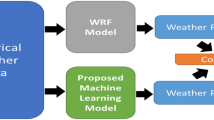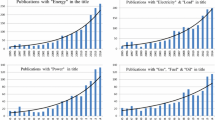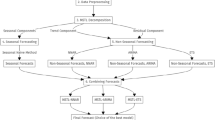Abstract
Accurate wind speed forecasting can effectively improve the balance of wind power generation and reduce the consumption of power system. However, many previous studies have only carried out wind speed point prediction or interval prediction, which may lead to incomplete analysis of wind speed. In this article, A nonlinear fuzzy forecasting system is designed for wind speed forecasting, and it is composed of four modules: the self-adaption feature selecting module, the point forecasting module, the fuzzy interval forecasting module and the evaluation module. In the first module, the weights of Intrinsic Mode Functions (IMFs) are calculated by the multi-objective optimization algorithm to reconstruct time series data, which can enhance the stability of forecasting effectively. In the point forecasting module, the nonlinear combined model based on Bi-directional Long Short-Term Memory (Bi-LSTM) are used for reducing the forecasting error and assisting the formulation of power dispatching strategy. Meanwhile, the fuzzy interval forecasting can analyze the wind speed fluctuation and help to arrange the rotating reserve. The results show the nonlinear hybrid forecasting system can not only give accurate wind speed forecasting for wind power generation management by point forecasting, but also provide effective reference for the grid rotating reserve through interval forecasting.


Similar content being viewed by others
Data availability
This paper chooses the data from two wind farms to test the established nonlinear hybrid forecasting system., one of which is named Sotavento in the southwest of Europe, in Galicia, Spain (N: 43, 354377°, W: 7, 881213°) and another farm is located in Penglai (37.48 N, 120.45 E).
References
Niu, X., Wang, J.: A combined model based on data preprocessing strategy and multi-objective optimization algorithm for short-term wind speed forecasting. Appl. Energy 241, 519–539 (2019). https://doi.org/10.1016/j.apenergy.2019.03.097
Bo, H., Niu, X., Wang, J.: Wind speed forecasting system based on the variational mode decomposition strategy and immune selection multi-objective dragonfly optimization algorithm. IEEE Access 7, 178063–178081 (2019). https://doi.org/10.1109/ACCESS.2019.2957062
Bo, H., Nie, Y., Wang, J.: Electric load forecasting use a novelty hybrid model on the basic of data preprocessing technique and multi-objective optimization algorithm. IEEE Access 8, 13858–13874 (2020). https://doi.org/10.1109/ACCESS.2020.2966641
Yang, H., Zhu, Z., Li, C., et al.: A novel combined forecasting system for air pollutants concentration based on fuzzy theory and optimization of aggregation weight. Appl. Soft Comput. 87, 105972 (2020)
Wang, C., Zhang, H., Ma, P.: Wind power forecasting based on singular spectrum analysis and a new hybrid Laguerre neural network. Appl. Energy 259, 114139 (2019). https://doi.org/10.1016/j.apenergy.2019.114139
Torres, J.L., García, A., De Blas, M., De Francisco, A.: Forecast of hourly average wind speed with ARMA models in Navarre (Spain). Fuel Energy Abstr. 47(4), 279 (2006). https://doi.org/10.1016/s0140-6701(06)81844-8
Xia, J., Ma, X., Wu, W., Huang, B., Li, W.: Application of a new information priority accumulated grey model with time power to predict short-term wind turbine capacity. J. Clean. Prod. 244, 118573 (2019). https://doi.org/10.1016/j.jclepro.2019.118573
Guo, Z.H., Wu, J., Lu, H.Y., Wang, J.Z.: A case study on a hybrid wind speed forecasting method using BP neural network. Knowl. Based Syst. 24(7), 1048–1056 (2011). https://doi.org/10.1016/j.knosys.2011.04.019
Qu, Z., Mao, W., Zhang, K., Zhang, W., Li, Z.: Multi-step wind speed forecasting based on a hybrid decomposition technique and an improved back-propagation neural network. Renew. Energy 133, 919–929 (2019). https://doi.org/10.1016/j.renene.2018.10.043
Fu, W., Wang, K., Li, C., Tan, J.: Multi-step short-term wind speed forecasting approach based on multi-scale dominant ingredient chaotic analysis, improved hybrid GWO-SCA optimization and ELM. Energy Convers. Manag. 187, 356–377 (2019). https://doi.org/10.1016/j.enconman.2019.02.086
Zhang, C., Zhou, J., Li, C., Fu, W., Peng, T.: A compound structure of ELM based on feature selection and parameter optimization using hybrid backtracking search algorithm for wind speed forecasting. Energy Convers. Manag. 143, 360–376 (2017). https://doi.org/10.1016/j.enconman.2017.04.007
Memarzadeh, G., Keynia, F.: A new short-term wind speed forecasting method based on fine-tuned LSTM neural network and optimal input sets. Energy Convers. Manag. 213, 112824 (2020). https://doi.org/10.1016/j.enconman.2020.112824
Malik, H., Fatema, N., Iqbal, A.: Chapter 8—Intelligent data analytics for wind speed forecasting for wind power production using long short-term memory (LSTM) network. In: Malik, H., Fatema, N., Iqbal, A. (eds.) Intelligent Data-Analytics for Condition Monitoring, pp. 165–192. Academic Press, Cambridge (2021). https://doi.org/10.1016/B978-0-323-85510-5.00008-9
Liu, H., Tian, H., Liang, X., Li, Y.: Wind speed forecasting approach using secondary decomposition algorithm and Elman neural networks. Appl. Energy 157, 183–194 (2015). https://doi.org/10.1016/j.apenergy.2015.08.014
Liu, M., Cao, Z., Zhang, J., Wang, L., Huang, C., Luo, X.: Short-term wind speed forecasting based on the Jaya-SVM model. Int. J. Electr. Power Energy Syst. 121, 106056 (2020). https://doi.org/10.1016/j.ijepes.2020.106056
Wei, D., Wang, J., Niu, X., Li, Z.: Wind speed forecasting system based on gated recurrent units and convolutional spiking neural networks. Appl. Energy 292, 116842 (2021). https://doi.org/10.1016/j.apenergy.2021.116842
Zhang, C., Wei, H., Xie, L., Shen, Y., Zhang, K.: Direct interval forecasting of wind speed using radial basis function neural networks in a multi-objective optimization framework. Neurocomputing 205, 53–63 (2016). https://doi.org/10.1016/j.neucom.2016.03.061
Khosravi, A., Nahavandi, S., Creighton, D.: A neural network-GARCH-based method for construction of Prediction Intervals. Electr. Power Syst. Res. 96, 185–193 (2013). https://doi.org/10.1016/j.epsr.2012.11.007
Zhao, H., Zhou, J., Wang, H.J., Yue, Y.J.: Short-term wind speed interval prediction based on LMD-FE and HGWO-ELM. China Sci. Aper 13(23), 2728–2734 (2018)
Khosravi, A., Nahavandi, S., Creighton, D., Atiya, A.F.: Lower upper bound estimation method for construction of neural network-based prediction intervals. IEEE Trans. Neural Netw. 22, 337–346 (2011). https://doi.org/10.1109/TNN.2010.2096824
Li, Y., Tong, Z., Tong, S., Westerdahl, D.: A data-driven interval forecasting model for building energy prediction using attention-based LSTM and fuzzy information granulation. Sustain. Cities Soc. 76, 103481 (2022). https://doi.org/10.1016/j.scs.2021.103481
Dragomiretskiy, K., Zosso, D.: Variational Mode Decomposition. IEEE Trans. Signal Process. 62(3), 531–544 (2014). https://doi.org/10.1109/tsp.2013.2288675
Zhang, Q., Li, H.: MOEA/D: a multiobjective evolutionary algorithm based on decomposition. IEEE Trans. Evol. Comput. 11(6), 712–731 (2007). https://doi.org/10.1109/tevc.2007.892759
Funding
This research was supported by the National Natural Science Foundation of China (Grant No. 71671029).
Author information
Authors and Affiliations
Contributions
HZ: Methodology, Software, Writing—Original Draft, Formal analysis, Original draft preparation, Visualization; JW: Conceptualization, Visualization, Writing—Review & Editing, Supervision, Reviewing and Editing, Funding acquisition; QL: Data curation, Investigation. Software, Reviewing and Editing, Data curation, Reviewing and Editing.
Corresponding author
Ethics declarations
Competing interests
The authors declare that there are no conflicts of interest regarding the publication of this paper.
Additional information
Publisher's Note
Springer Nature remains neutral with regard to jurisdictional claims in published maps and institutional affiliations.
Rights and permissions
Springer Nature or its licensor (e.g. a society or other partner) holds exclusive rights to this article under a publishing agreement with the author(s) or other rightsholder(s); author self-archiving of the accepted manuscript version of this article is solely governed by the terms of such publishing agreement and applicable law.
About this article
Cite this article
Zhang, H., Wang, J. & Li, Q. Nonlinear fuzzy forecasting system for wind speed interval forecasting based on self-adaption feature selecting and Bi-LSTM. SIViP 18, 1249–1258 (2024). https://doi.org/10.1007/s11760-023-02759-w
Received:
Revised:
Accepted:
Published:
Issue Date:
DOI: https://doi.org/10.1007/s11760-023-02759-w




